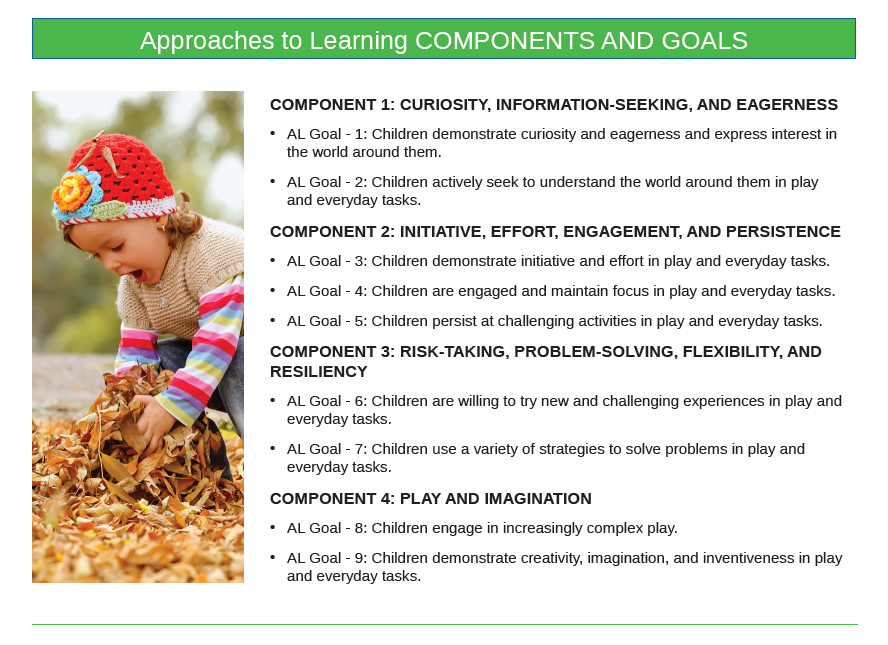
Approaches to Learning (AL)
Approaches to Learning Domain
Children are born with an inclination to learn and to figure things out, but each child approaches learning in his or her own way. The Approaches to Learning domain addresses how children learn and includes children’s attitudes toward and interest in learning. It reflects behaviors and attitudes such as curiosity, problem-solving, maintaining attention, and persistence. These are general characteristics that children display as they learn in all domains and curriculum areas.
For infants and toddlers, their approach to learning begins with their openness and interest in the world around them. They learn through their senses; tasting, touching, smelling, listening, and looking at anything and everything in their environment. They also learn through moving their body as they try new actions and see how they can impact the world around them when they do something with objects. When adults support children's efforts, they feel safe and secure and are more willing to try new things and take risks. When responsive adults encourage exploration in a stimulating environment, young children have the emotional security necessary for exploring, growing, and learning.
As children move into the preschool years, they begin to establish learning behaviors that are more obviously tied to later school success. They become more confident in their ability to learn, and through play, enjoy exploring how the world works. This is also a time when children develop some specific areas of interest and learn different strategies to find out more about those interests. Typically, they are able to concentrate for longer periods of time and are likely to persist towards completion of tasks even after encountering obstacles.
Adults can support children in developing positive approaches toward learning by setting up safe environments that offer a selection of interesting materials that children can explore freely. Time to play, explore, and experiment is essential. Adults who encourage children’s creativity and risk-taking help children develop positive attitudes and behaviors that guide their approach to learning. With guidance, technology and interactive media, can also provide opportunities for children to try out creative solutions to problems, ask questions, and find information about new topics. Adults can encourage children to be curious, express creativity, solve problems and initiate efforts during every part of the day in both indoor and outdoor settings.
It is important for adults who work with young children to recognize that children vary in their learning styles and in how they express their approach to learning. For example, some children show great enthusiasm for trying new things, while others are more content to sit back and watch. These differences may be the result of the child’s temperament, cultural differences in how families encourage children to interact with the environment, and/or disabilities that may affect how children take in information. Adults must be attuned to these differences and provide support and guidance to children as they need it. This domain describes important aspects of approaches to learning that adults should seek to foster as they work with young children while also respecting individual approaches to learning.

Component 1: Curiosity, Information-Seeking, and Eagerness
Component 2: Initiative, Effort, Engagement, and Persistence
Component 3: Risk-Taking, Problem-Solving, Flexibility, and Resiliency
Component 4: Play and Imagination
